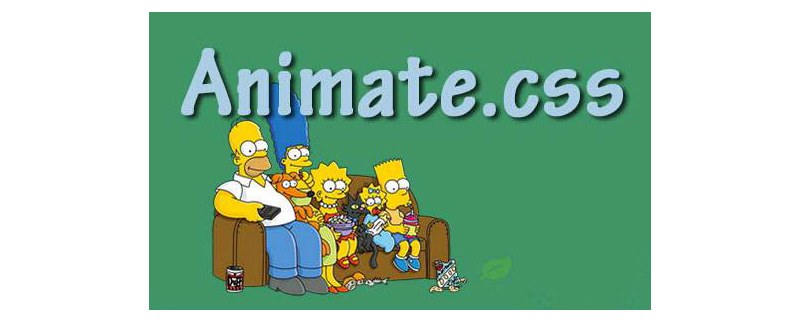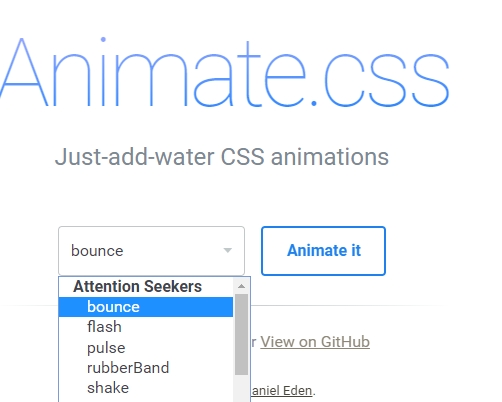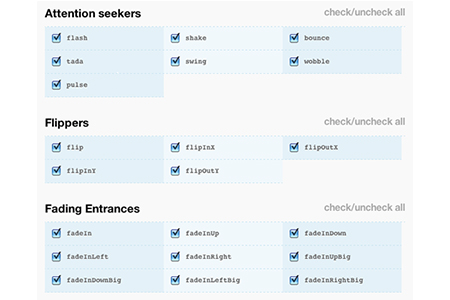How to use the animate.css animation library
How to use the animate.css animation library: introduce it into the code through the link tag, and then add the animated class and the animation class name of the required animation effect to the mark element to be animated
Animate.css is a simple CSS library that can set animations on web pages without writing too much CSS code. It is actually a collection of ready-to-use libraries for CSS3 animation effects. The library provides a total of more than 50 different animations including shake, flash, bounce, flip, rotate (rotateIn/rotateOut), fadeIn/fadeOut, etc. Effects, these effects are consistent on most browsers that support CSS3

[Recommended course: CSS3 Tutorial]
First we need to download the Animate.css library and introduce it into our code through the link tag
Download address: http://cdn.bootcss.com/animate .css/3.5.2/animate.min.css
<link href="http://cdn.bootcss.com/animate.css/3.5.2/animate.min.css" rel="stylesheet" type="text/css">
After loading the Animate.css library into the web page, we can access all the animations written in it and on the elements To call an animation
First you must add the animated class to the element to be animated, then add a space, and then add the class name of the animation effect you want
We can use the following link Find the class name of the animation effect we want and view the animation effect
Link address:https://daneden.github.io/animate.css/


Example: Add a hinge animation effect
<h1 id="PHP中文网">PHP中文网</h1>

If you want to pass some Events to trigger effects can be achieved through JavaScript. We can trigger the click event and add the class to the element
Example:
<h1 id="PHP中文网">PHP中文网</h1>
Rendering:

Similarly We can also use animation delay and animation iteration count to change the delay in the animation and the number of plays
.animated{
-webkit-animation-iteration-count:5;
-webkit-animation-duration:1s;
animation-iteration-count:5;
animation-duration:1s;
}Rendering:

Summary: That’s it for this article That’s the entire content of the article. I hope that this article can help everyone understand the animate.css animation library.
The above is the detailed content of How to use the animate.css animation library. For more information, please follow other related articles on the PHP Chinese website!

Hot AI Tools

Undresser.AI Undress
AI-powered app for creating realistic nude photos

AI Clothes Remover
Online AI tool for removing clothes from photos.

Undress AI Tool
Undress images for free

Clothoff.io
AI clothes remover

Video Face Swap
Swap faces in any video effortlessly with our completely free AI face swap tool!

Hot Article

Hot Tools

Notepad++7.3.1
Easy-to-use and free code editor

SublimeText3 Chinese version
Chinese version, very easy to use

Zend Studio 13.0.1
Powerful PHP integrated development environment

Dreamweaver CS6
Visual web development tools

SublimeText3 Mac version
God-level code editing software (SublimeText3)

Hot Topics
 1387
1387
 52
52
 Building an Ethereum app using Redwood.js and Fauna
Mar 28, 2025 am 09:18 AM
Building an Ethereum app using Redwood.js and Fauna
Mar 28, 2025 am 09:18 AM
With the recent climb of Bitcoin’s price over 20k $USD, and to it recently breaking 30k, I thought it’s worth taking a deep dive back into creating Ethereum
 Vue 3
Apr 02, 2025 pm 06:32 PM
Vue 3
Apr 02, 2025 pm 06:32 PM
It's out! Congrats to the Vue team for getting it done, I know it was a massive effort and a long time coming. All new docs, as well.
 Can you get valid CSS property values from the browser?
Apr 02, 2025 pm 06:17 PM
Can you get valid CSS property values from the browser?
Apr 02, 2025 pm 06:17 PM
I had someone write in with this very legit question. Lea just blogged about how you can get valid CSS properties themselves from the browser. That's like this.
 A bit on ci/cd
Apr 02, 2025 pm 06:21 PM
A bit on ci/cd
Apr 02, 2025 pm 06:21 PM
I'd say "website" fits better than "mobile app" but I like this framing from Max Lynch:
 Stacked Cards with Sticky Positioning and a Dash of Sass
Apr 03, 2025 am 10:30 AM
Stacked Cards with Sticky Positioning and a Dash of Sass
Apr 03, 2025 am 10:30 AM
The other day, I spotted this particularly lovely bit from Corey Ginnivan’s website where a collection of cards stack on top of one another as you scroll.
 Using Markdown and Localization in the WordPress Block Editor
Apr 02, 2025 am 04:27 AM
Using Markdown and Localization in the WordPress Block Editor
Apr 02, 2025 am 04:27 AM
If we need to show documentation to the user directly in the WordPress editor, what is the best way to do it?
 Comparing Browsers for Responsive Design
Apr 02, 2025 pm 06:25 PM
Comparing Browsers for Responsive Design
Apr 02, 2025 pm 06:25 PM
There are a number of these desktop apps where the goal is showing your site at different dimensions all at the same time. So you can, for example, be writing
 Let's use (X, X, X, X) for talking about specificity
Mar 24, 2025 am 10:37 AM
Let's use (X, X, X, X) for talking about specificity
Mar 24, 2025 am 10:37 AM
I was just chatting with Eric Meyer the other day and I remembered an Eric Meyer story from my formative years. I wrote a blog post about CSS specificity, and




